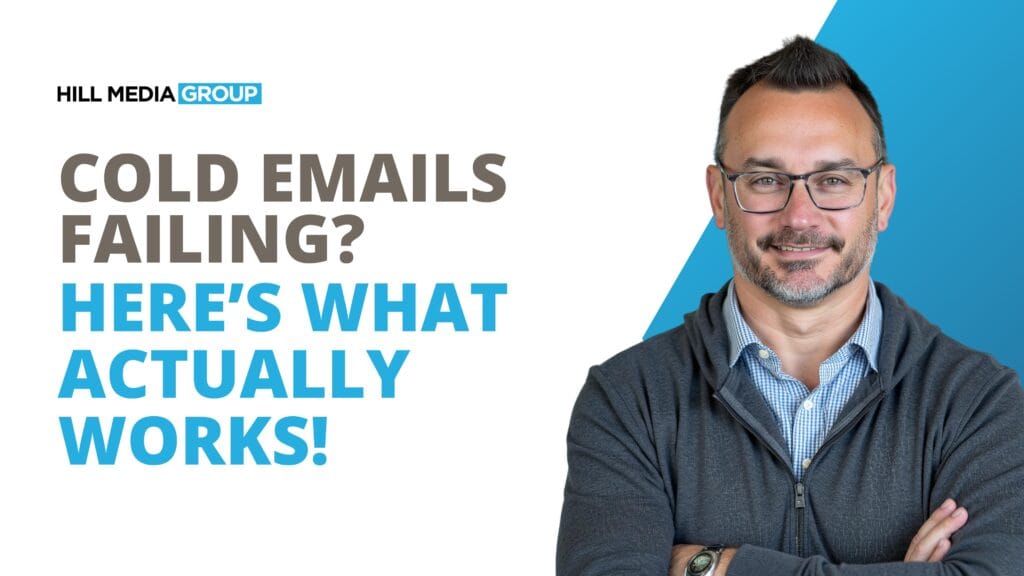Your inbox is a battleground.
Right now, you’re probably sitting on 47 unread emails. Half of them are cold outreach from people you’ve never met, pitching services you don’t need, using templates you’ve seen a dozen times before. You’ve learned to scan subject lines in milliseconds, deciding what deserves attention and what gets deleted without a second thought.
Here’s the uncomfortable truth: your prospects are doing the exact same thing to your emails.
Every business owner I talk to has the same complaint: “I’m sending hundreds of emails, but nobody’s responding.” They’ve bought the lists. They’ve crafted the templates. They’ve set up the automation. And they’re getting… crickets.
The problem isn’t that cold email is dead. The problem is that everyone else discovered it too.
The Inbox Crisis Nobody Wants to Talk About
Let’s look at what’s actually happening to your carefully crafted cold emails in 2025:
If you’re using mass email tools, here’s the reality:
- Open rate: Most campaigns report 23.9% to 27.7% open rate (and that’s if you’re doing it well)
- Click-through rate: 2-5%
- Reply rate: 1-8.5%
- Inbox placement: Only 1.53% actually make it to the inbox
- Promotions tab: 91.18% of marketing emails land here on Gmail
- Spam folder: 7-15% go straight to spam
Translation: If you send 1,000 emails, maybe 15 make it to an inbox. Of those, 910 land in the Promotions tab where most people never look. Perhaps 230-280 people actually open it. Maybe 20-50 click through. And if you’re lucky, 10+ people reply.
That’s a lot of work for maybe 10 responses.
But here’s where it gets worse.
Your Domain Reputation Is On Borrowed Time
Every mass email campaign you run is making a withdrawal from your domain’s reputation bank account.
Email service providers like Gmail, Yahoo, and Outlook are watching:
- Your bounce rate (they want it under 2%)
- Your spam complaint rate (they want it under 0.1%)
- How many people actually engage with your emails
- Whether recipients mark you as spam
Send enough low-engagement emails, and your domain gets flagged. Once that happens, even your legitimate business emails, the ones to actual customers, start landing in spam folders.
The current best practice? Use a separate domain for cold outreach so you don’t destroy your primary domain’s reputation. Buy yourbusiness.net or yourbusiness.co, set up email there, and use that for cold campaigns.
That should tell you everything you need to know about the sustainability of mass email marketing.
The Tools Your Prospects Are Using Against You
While you’re optimizing subject lines and A/B testing email templates, your prospects are fighting back with AI.
Tools like SaneBox use artificial intelligence to automatically filter emails. It learns what matters to each user and quietly moves everything else out of the way. That cold email you spent 20 minutes crafting? SaneBox moved it to a “SaneNews” folder before your prospect ever saw it.
And here’s the thing, I use SaneBox myself. It’s brilliant for managing inbox overload. It learns that I don’t want to see most cold outreach, so it filters it automatically. I check that folder maybe once a week, and even then, I’m scanning for anything that looks different. If I see something I don’t want to see again, it goes in the SaneBlackHole, and that sender will never show up in my inbox again.
(By the way, if your inbox is overwhelming, try SaneBox. It’s one of the few tools that actually delivers on its promise to clean up email chaos.)
The point is: your prospects aren’t even seeing your emails anymore. Not because they’re rude, but because they’ve deployed technology specifically designed to hide messages like yours.
The Math That Changes Everything
Now let’s look at what happens when you send personalized, one-to-one emails instead:
Personalized 1-to-1 outreach metrics:
- Open rate: 40-60%
- Click-through rate: 12-18%
- Reply rate: 15-50% (top performers hit 60%)
- Inbox placement: 90-99%
- Promotions/Spam: Less than 2%
Let me put that in perspective:
Scenario A – Mass Email Approach:
- Send 1,000 emails
- Get 230-280 opens
- Receive 10-15 replies
- Time invested: 5-10 hours (list building, template creation, setup)
- Risk: Damaged domain reputation
Scenario B – Personalized Video Approach:
- Send 50 personalized videos
- Get 20-30 opens
- Receive 8-25 replies
- Time invested: 5-10 hours (same as mass email)
- Risk: Virtually none
Same time investment. Similar or better response rate. Zero risk to your domain. And you’re building actual relationships instead of hoping to avoid the BlackHole.
Why Video Changes Everything
Here’s what I discovered after analyzing the results of businesses that send text-based cold emails: Nobody expects you to make them a video.
When someone receives a personalized video, several things happen simultaneously:
- The movement captures attention – A GIF preview in the email shows their website and your face. It’s visually impossible to ignore.
- It proves you did your homework – You can’t fake a screen recording of their specific website.
- It’s harder to delete – There’s a human on the other side who clearly invested time. Most people will at least watch it.
- You stand out completely – While everyone else is sending text, you’re the only one who showed up in person (virtually).
Real Example Video:
Embedable GIF for Email:
Actual Email Sent:

The video example above demonstrates the key features you’ll want to leverage:
- Your webcam in the corner – This makes it personal and human
- Screen recording of their website – Shows you’ve done specific research
- Clear, scripted messaging – You’re not rambling; you’ve prepared something valuable
- Professional but authentic – It’s polished enough to respect their time, raw enough to feel real
Note: In my example, I had previous contact with this client, so I deviated from my script quite a bit. The goal here is to show some appreciation for what is working well, but then focus on how you can help.
The Loom Strategy: Step-by-Step
Here’s exactly how to implement this approach:
1. Choose Your Tool
- Price: $15/month (paid annually) or free for limited use
- Pros: Mobile app, AI-powered features, automatic GIF generation, easy editing
- Best for: If you need mobile recording or want AI transcription/summaries
- Price: $8.13/month (paid annually) or $58 for lifetime desktop license
- Pros: Nearly half the price of Loom, one-time payment option available
- Cons: No mobile app (desktop only), fewer AI features
- Best for: Budget-conscious users who only need desktop recording
Both tools make it incredibly easy to record, edit, and share. If budget isn’t a concern and you want mobile capability, go with Loom. If you want to minimize recurring costs, Cap’s lifetime license is hard to beat.
2. Develop Your Script with AI
This is where AI actually helps instead of hurts. Use ChatGPT or Claude to create your script:
Prompt example:
I'm a [your business type] reaching out to [target audience/business category]. I want to create a 60-90 second Loom video introducing my services while screen recording their website.
Write me a script that:
- Opens with acknowledging something specific about their business
- Identifies a problem or opportunity I noticed
- Briefly explains how I can help
- Ends with a clear, low-pressure call to action
Keep it conversational and authentic, not salesy.
Target audience: [Video production companies / Fleet managers / etc.]
My service: [Voiceover services / Fleet maintenance / etc.]
The AI will give you a solid foundation. Then personalize it for your voice and style.
3. Practice Your Script
Put the script on a second monitor or use a tablet next to your screen. Read through it 3-4 times before recording. You want to be comfortable enough that you can maintain a conversational tone while reading.
You’re not memorizing it word-for-word. You’re familiarizing yourself with the flow so you can be natural.
4. Record Your Video
- Open your screen recording tool (Loom or Cap)
- Navigate to the prospect’s website
- Turn on your webcam (position it so your face shows in a corner)
- Hit record
- Follow your script, personalizing with their company name and specific details
- Keep it under 2 minutes
Pro tip: The first 10 videos will feel awkward. By video 20, you’ll have the rhythm down and can knock these out in 5 minutes each.
Pro Plus tip: Make sure you are in a quiet space so there isn’t distracting background noise in your video.
5. Quick Edit
Both Loom and Cap have simple editing tools. If you coughed or stumbled badly, just trim that section out. Don’t aim for perfection; authenticity matters more.
6. Generate Your Shareable Link and GIF
- Get the shareable link to your video
- Generate a GIF preview (Loom does this automatically; Cap users can use the screenshot sharing feature)
- Make sure the video is set to public or unlisted (not private)
7. Send the Email
Keep the email itself short:
Subject: Quick idea for [Company Name]
Body: Hi [First Name],
I was looking at [Company Name]’s website earlier and noticed [specific observation]. Made me think you might be interested in [brief value proposition].
Put together a quick video walking through what I’m thinking:
[GIF preview – linked to video]
No pressure—just thought it might be helpful.
Best, [Your Name]
That’s it. Short email. Big value in the video.
Real-World Applications
Example 1: Local Service Business (Auto Repair → Fleet Accounts)
Mike owns an auto repair shop in Kalispell, Montana. He has five large service bays that are underutilized during weekday mornings. He wants to land fleet maintenance accounts with local delivery companies.
His Loom strategy:
- Identifies 20 local businesses with vehicle fleets (delivery services, contractors, property management companies)
- Visits their website and finds their “Fleet” or “About” page showing their vehicles
- Records a video on his phone:
- Starts with their website showing their fleet
- Walks into his shop showing the large bays
- Explains his capacity for quick turnaround maintenance
- Mentions his mobile service for emergency calls
- Sends the video with a simple email offering a free fleet assessment
Why this works: Fleet managers get cold calls constantly. They rarely get a video tour of a facility specifically addressing their needs. Mike’s video proves he has the capacity, shows his professionalism, and makes it personal.
Example 2: Wider Reach Business (Voiceover Artist → Production Companies)
Steve is a voiceover artist trying to build relationships with video production companies nationwide. He’s competing with thousands of other VO artists, many using the same mass email approach.
His Loom strategy:
- Identifies video production companies by niche (corporate, commercial, e-learning)
- Visits their portfolio page
- Records a screen video:
- Opens with complimenting a specific video in their portfolio
- Does a brief voiceover read in the style that would match their content
- Explains his turnaround time and process
- Shows his studio setup briefly via webcam
- Sends the video demonstrating his actual voice quality and professionalism
Why this works: Production companies can read demos all day. But Steve is showing them exactly what their project would sound like with his voice, while proving he took time to understand their work. He’s not one of 100 generic emails; he’s the guy who actually did homework.
Example 3: Any B2B Service
The framework works for almost any business-to-business service:
- Web designers: Record a quick audit of their current site
- Marketing consultants: Screen record their Google Business Profile with improvement suggestions
- CPAs: Walk through a tax strategy relevant to their industry
- Commercial cleaning: Show your team, equipment, and process via video
The pattern is always the same: Show them something specific about their business + demonstrate your expertise + make it personal.
When to Use Which Approach
Both mass email and personalized outreach have their place. Here’s how to decide:
Use mass email when:
- Your service is low-cost (under $500)
- The decision is transactional, not relational
- You’re targeting a very large audience where small conversion rates work
- You’re willing to use a separate domain and accept lower engagement
Use personalized video outreach when:
- Your service is higher-ticket ($1,000+)
- You’re building ongoing relationships (retainers, long-term contracts)
- Your target audience is specific and manageable (under 500 prospects)
- You need to differentiate yourself in a crowded market
- Trust and credibility matter to the sale
For most service-based businesses and B2B companies, the personalized approach wins. Yes, you’ll reach fewer people. But you’ll connect with more of them.
Getting Started This Week
If you’re ready to try this approach, here’s your action plan:
Day 1: Set up your tool
- Sign up for Loom (free to start) or Cap (lifetime license for $58)
- Record a test video to get comfortable with the interface
- Practice with the built-in editing tools
Day 2: Build your script
- Use AI to create your baseline script
- Personalize it for your voice and industry
- Practice reading it 3-4 times
Day 3: Identify your first 10 prospects
- Find businesses that fit your ideal client profile
- Make sure they have websites you can reference
- Gather contact information for decision-makers
Day 4-5: Record and send
- Create your first 5 videos
- Send them out with simple, short emails
- Don’t overthink it. Done is better than perfect
Week 2: Refine based on results
- Review which videos got responses
- Adjust your script based on feedback
- Record your next 10
Protecting Your Domain (If You Still Use Mass Email)
If you’re going to continue using mass email campaigns alongside personalized outreach, protect your primary domain:
- Buy a secondary domain – Get a .net or .co version of your business name
- Set up email properly – Configure SPF, DKIM, and DMARC records
- Warm up the domain – Send small volumes initially, gradually increasing
- Monitor your metrics – Keep bounce rates under 2% and spam complaints under 0.1%
- Use your primary domain for real relationships – Save your main email for customers, partners, and personalized outreach
This way, if your mass email domain gets flagged, your business email stays clean.
The Bottom Line
Your cold emails are going unanswered because they look like everyone else’s cold emails.
Prospects aren’t ignoring you because they’re rude. They’re protecting their attention in a world where hundreds of people want a piece of it every single day. AI tools are helping them filter out noise, and email providers are getting better at identifying bulk campaigns.
The solution isn’t to send more emails. It’s to send better ones.
Personalized video outreach isn’t scalable in the traditional sense. You can’t send 10,000 videos the way you can send 10,000 emails. But that’s exactly why it works. The limitation creates the value.
When someone receives a video you made specifically for them, they know you can’t be sending hundreds of these. The effort itself becomes the message: “I think you’re worth my time.”
And in a world drowning in automation, that message cuts through everything else.
Recommended Tools:
- Loom: https://loom.com – Full-featured screen recording with mobile app and AI tools ($15/month or free basic)
- Cap: https://cap.so – Budget-friendly alternative with lifetime license option ($8.13/month or $58 lifetime)
- SaneBox: https://sanebox.com – AI-powered inbox management to protect your own attention
Full disclosure: Some links in this article are affiliate links, which means we may earn a small commission if you sign up. We only recommend tools we actually use and believe deliver real value. The strategies and advice in this article remain the same regardless of whether you use our links.





